- Home
- Gary Vaynerchuk
Crushing It! EPB Page 3
Crushing It! EPB Read online
Page 3
The most exciting thing about the business world we live in is that it is still in its infancy. There is so much room to succeed here. Unbelievably, a lot of you still seem to balk at experimenting with new up-and-coming platforms. You don’t want to waste your time if it turns out to be just another fast-fading trend, but then you wonder why influencers like the ones you’re about to meet are succeeding so much better than you are. That disconnect is what gives entrepreneurs like you such an early advantage. Now there is even more opportunity to cash in on your passion than there was back then. Grab your spot, make your mark, and start living in the Crush It! universe.
How I’m Crushing It
Amy Schmittauer, Savvy Sexy Social
IG: @Schmittastic
Amy Schmittauer became an Internet sensation because she got picked last to be a bridesmaid. It was 2007, and though she was the last one chosen, she wanted to be the favorite, so she thought about what she could do to make the bride feel special and came up with the idea of making a video with one of the other bridesmaids. She had fun making it and was sure the bride would appreciate the gesture, but it wasn’t until she played it at the rehearsal dinner that she realized the power of the medium. The bride wasn’t the only one crying over the video; the whole room was moved to tears.
“I got hooked immediately. I loved the idea of telling a story and being able to have an emotional control over an audience. It engages all the senses at once.”
The video Amy had made for the wedding was burned onto a DVD. She was thrilled, however, to discover the existence of online platforms onto which she could upload videos and share them. She started filming pieces of her life, taught herself how to edit, and displayed the results on YouTube. The process became her creative outlet.
In the meantime, while majoring in political science at The Ohio State University, thinking she might want to go to law school, she managed to get a dream job at a law firm, where she eventually got involved in lobbying, fund-raising, and public policy. But she also became known as the person who knew how to edit videos and could help you figure out the privacy settings on your Facebook page, which would not have been remarkable in Silicon Valley but was unusual in Ohio at the time. It was friends living on the West Coast who informed her that social-media management was a real job. And she thought, I could get paid to do this?
That’s when the side hustle started. After getting home from her day job, sometimes as late as seven p.m., she’d buckle down to the freelance work. The first small businesses she approached were already overwhelmed by all the content they had to create for Facebook and Twitter, and now here’s this person telling them they had to make videos, too? They didn’t want to hear it. Amy realized that the only way she was going to get small companies to take her seriously was to show them why social mattered. She got her first client, a local sustainable food magazine, by sending an e-mail explaining that although she didn’t have any formal social-media experience, she was sure she could help them develop their brand. Oh, and she was willing to do it for free. It didn’t take a lot of convincing for them to take her on as their social-media manager.
She had been working the side job along with her full-time job at the law firm for three or four months when Lewis Howes, also from Ohio, who was by then making a name for himself with LinkedIn (see Chapter 2), suggested they meet. He didn’t find her through the work she was doing for the sustainable food magazine; he had noticed the photo and video blogging she was doing on YouTube and other social-media sites, and wanted to know more about what she was doing. They met over burgers in the spring of 2010, and he gave her two pieces of advice if she wanted to start getting paying clients:
Go to Las Vegas and attend BlogWorld, the new-media conference where the leaders in blogging, podcasting, and video content creation gather to talk about their craft and businesses. Not a problem. The magazine had already helped her purchase a badge.
Read Crush It!, by Gary Vaynerchuk. That was easy, too. Amy went to the library and picked up a copy. She read it, and that’s when she knew she wasn’t going to become a lawyer after all.
I would have been happy to do this as a side job forever. I didn’t know that I could be powerful enough to make this happen. Crush It! made me able to envision what my future could look like. I’d been thinking that I first needed to become a prestigious company to get other businesses to hire me, and I didn’t give enough credit to the fact that I was already being watched, asked for advice, trusted, and considered a mini–thought leader because of the personal brand I’d developed through the videos about my life.
It made me realize how important personal branding is to growing a business, and I was already doing it without even knowing it. So maybe I was further ahead than I thought! Maybe I could turn this thing I was doing for fun into something else by simply leveraging what I knew really well—how to use video, how to talk to a camera like it’s a person—and then craft the messaging for a very specific type of person. It was the only fire I ever really needed to hit the ground running because I knew what to do at that point.
Now she knew that social-media management wasn’t going to be her sector of the online world. She was going to go after vlog and personal brand consulting. And she was going to ask for what she was worth.
Obviously, the definition of devaluing yourself is working for free, but I also think I would have stayed too low in my pricing because of how much it was devalued as an industry in the beginning. Crush It! allowed me to wrap my mind around the fact that my skill was a major, major asset, both in marketing and customer service for businesses. That’s what made me a lot more confident in my pricing and monetizing on my terms. And my confidence, believing that I’m worth more, has helped me get paid much more over my career. I just kept taking the chance, because I knew I was doing good work.
She started her vlog, Savvy Sexy Social, “to end the misery that small businesses were going through.” By the time she quit her job in the beginning of 2011, she had gotten some paying clients, but the switch from salaried employee to freelancer was still a huge risk. She moved in with her boyfriend, got rid of her car, and did everything she could to keep her overhead low. She was prepared for it to take months to bring in new clients, but all the work she’d done in the wings—getting people to know and trust her by talking about her work, attending BlogWorld, following up with her network, and being diligent with building relationships—paid off. She had paying clients within a few weeks. (To make sure she stood firm on her prices, for a while she created a separate virtual assistant e-mail and negotiated for herself under a different persona.)
While continuing to teach on Savvy Sexy Social, which has over seventy-five thousand subscribers and has received over five million views, Amy has written a best-selling book, created a series of online courses on vlogging for business, and started a second successful video marketing business, and she still presents keynotes all over the world. She’s newly married (hello, Mrs. Landino!), she has a cute dog, and business is thriving. By any measure, she’s crushing it, yet she’s reluctant to congratulate herself.
I’ve had a hard time fully appreciating what I’ve accomplished at any point. I understand that I am in complete control, and that’s an overwhelming feeling because it means you could always be doing more, and it means you might not be doing enough. Amazing things happen, and then there’s a day when I wake up and it’s a bad day and it’s like, I’m failing. I never got close to quitting, but there were days when I was thinking, Are you really cut out for this? I was my own biggest challenge. I didn’t take the time to be grateful and give myself the respect that I had come so far. It sounds fluffy, but I had to start sitting down and reflecting on a weekly, daily, monthly basis on what I did well, and be happy with that, and remember it the next day, because it’s going to be hard every day. Waking up and knowing the challenges will come—and they do—I still wouldn’t change a thing. I know I chose my right path, and I love continuing to follow it no matter what.
/>
Amy has a great story, right? I love how she scratched her own itch. I love how she successfully channeled all her energy into creating an incredible brand, and yet despite having accomplished so much, continues to navigate and doesn’t let up for one second. She is the embodiment of patience and tenacity, as are all the other people we interviewed for this book. I can’t wait for you to meet them.
2
What (Still) Matters
Before we explore which platform you should select to support your pillar of content, I want to remind you that even a well-designed pillar will fall if it isn’t set in a solid base. What usually hamstrings entrepreneurs isn’t merely the mistakes they make when executing their vision, but the mistakes they make before they even get started. While it can be hard to pinpoint why some influencers build attractive, lucrative personal brands that succeed beyond their wildest expectations, it’s not hard to figure out why so many who attempt to do it fail. In general, it’s because they’re putting their energies into the wrong things. They care, but not enough about what really matters. And what really matters is a pretty short list: intent, authenticity, passion, patience, speed, work, and attention.
Intent
In business, the how matters, of course, but the why matters just as much. Maybe more. Why do you want to be an entrepreneur?
To share your knowledge?
To help people?
To build something that leaves a legacy?
To make a good income to give yourself and your family financial security and breathing room?
To have fun with a creative outlet?
To create community?
All of these are great reasons for building a business and becoming an influencer.
Notice what isn’t on the list?
With entrepreneurship becoming so trendy, a lot of people are calling themselves entrepreneurs who really aren’t. They should call themselves wantrepreneurs instead, and I wish they’d do this before they ruin the reputation of real entrepreneurs the same way unscrupulous brokers ruined how some feel about real estate agents or the way ambulance chasers and media hounds tarnished our opinion of lawyers. (And I wish they’d rename themselves before they waste a lot of time and potentially money). I promise you that getting into this game for the gold is the quickest path to long-term failure. When your intent is coming from the wrong place, customers may still do business with you if they have no other option (an increasingly rare situation), but they won’t tell others to. By definition, an influencer engenders positive word of mouth. If you don’t care enough to induce others to rave about you, all you’re doing is holding a spot for someone who really does care, the one who will waltz in and displace you.
This book features entrepreneurs at all levels of financial success and all stages of influence, but those currently at the pinnacle of both share three characteristics:
A commitment to service
A desire to provide value
A love of teaching
A number were inspired to create their products after unsuccessfully searching for those products themselves, sure that if they needed them, others did, too. They started teaching when all they found when looking for mentorship or inspiration were overpriced online courses that took up their time but didn’t offer anything truly useful. When creating their content, they vowed to take the completely opposite approach by offering solid content and real value. By their own admission, most didn’t start out as the most knowledgeable in their fields, and they certainly weren’t the most polished. But what they lacked in experience they made up for in earnestness, honesty, and humor. Every day their podcasts, photos, videos, and blog posts improved, drawing their audiences back again and again. They gave, gave, gave, gave, and gave some more, often for free. And customers came back again and again. Was it because they liked getting stuff for free? Sure, everyone does. But if a product stinks, even free won’t make up for your customers’ disappointment. In addition, a stinky product blows any chance you might have had to earn your customers’ trust and loyalty. No one comes back for products or advice that doesn’t work.
Now, I’m the least naïve person you’ve ever met. Some may hate me for saying this, but I don’t believe that most of these people give so much away because they’re so goddamn selfless. They’re human, which means that, like everyone else, they have their own selfish wants and needs. But I also believe they are humans who fall into the 51 percent. That is, if your nature is at least 51 percent altruistic and only 49 percent selfish, you have a real shot at breaking out, because the vast majority of people are 70 to 99 percent selfish. Could you use altruism as a tactic? Sure, but altruism is not the kind of thing you can fake for very long. All the people I’ve known who’ve tried have been able to grow only so big before they were financially and/or emotionally broke. I’ll bet some of the people mentioned in this book started out using altruism as a tactic, and they were good at it because it came naturally. Then they noticed that consumers react pretty strongly when they feel that you give a shit about them, which gave them the incentive to play up that side of themselves rather than fight it, which is what most of us rocked in the cradle of capitalism have always been taught to do. Breaking the money-first rule is also how I got to where I am. I have never cared about the money. I do, however, care deeply, obsessively, about my legacy. I want the world to mourn me when I die, not just for being a decent human being, but for building something tremendous and predicting where the future of business lay. And then I want to fucking own the afterlife. Being good and generous and giving a crap is the only thing that will get me either of those goals. Three out of ten people don’t like me the first time they catch me online or hear me talk because they think I’m full of shit, and that my habit of giving so much away for free, whether it’s time, advice, or mentorship, is just a gateway to making money. They don’t believe anyone really cares that much. I do, though, which is why the majority of my haters eventually change their minds if they give me a fair hearing.
There are a scary number of people who say they’re starting their business because they want to make the world a better place yet reveal themselves as frauds and hypocrites in answering one or two direct questions about their model. There are also a scary number of people who are so cynical that they can’t believe anyone does anything without expecting something in return. I acknowledge the duality of human nature, including my own. I want to buy the New York Jets (let’s be honest; I’m addicted to the process of trying to buy the New York Jets), which means I do what I do so I can make a lot of money. At the same time, I love how it feels to make a positive impact on people’s lives, which means I do what I do so I can help other entrepreneurs succeed. Embracing these two truths and combining them in my daily actions is why I win. It’s also why I leave ungodly amounts of money on the table. For example, many influencers, including some you’ll meet here, sell online courses. Courses can provide a hefty revenue stream, and done right, they can be incredible resources. I choose not to because I’m concerned that, once I put a monetary value on what I know, I’ll feel obligated to reserve my best stuff for the people willing to pay. It would create a conflict of interest that would go against everything I want my brand to be about. I do publish books, but other than an occasional personal anecdote, there’s no information in them that I have not discussed in a public, free forum somewhere else. For anyone with the time and inclination to do the online digging, the information is there for the taking, albeit sometimes in a less expansive, less detailed format. These books exist to save people time and to provide a portable resource people can easily refer to.
In every decision I make, I consider the balance I’m willing to strike between selfishness and selflessness, with my selfish side often getting short shrift in the short term. I’m fine with waiting a few more years than I might otherwise have to to buy the Jets if it means I get to live with a clear conscience and the knowledge that I haven’t sacrificed my legacy. You may make a different decision. The tr
uth is, you don’t have to be as altruistic as I am to win big; in a world where the standard is pretty much nothing, you have to be just altruistic enough. But believe me, if your every interaction and transaction is predicated on what you think you’re going to get out of it, nothing in this book will work for you. Consider yourself warned.
At the other end of the spectrum, it’s interesting how often the product actually seems beside the point to many of the successful entrepreneurs interviewed for this book. Their passion isn’t entirely tied up in the protein powder, the training technique, or the beauty products. For many of them, to borrow the words of graphic design and branding instructor Jenna Soard (IG: @youcanbrand), founder of You Can Brand, their “truest love is watching the ‘ahas’ go off in people’s minds.” It’s in seeing how their product or service makes others feel, in helping customers solve problems, achieve more, or feel better about themselves. In short, the source of their success lies in how much they
CARE.
Still the best marketing strategy ever.
How I’m Crushing It
Lewis Howes, School of Greatness
IG: @LewisHowes
Lewis Howes knows the sound of a broken dream. For him, it was the snap of his wrist as he slammed against a wall during his second game as a professional arena football player. An All-American football player and decathlete, Lewis at first refused to accept that the injury meant he’d never play professional sports again. For six months as he recuperated from extensive surgery in a full-arm cast on his sister’s couch in Ohio, he held out hope that he’d recover enough to resume his athletic career. But after another year of trying and failing to rebuild the strength he’d once had in his arm, he had to accept that it was over. For a lot of people, it would have felt like the end. He’d already survived childhood sexual abuse and been bullied in school, where he had struggled to keep up due to dyslexia. Sports had been his refuge and his salvation, and he’d dropped out of college to try out for the NFL. Now, despite all his efforts, he was left with nothing—no degree, no skills, and no money. And it was 2008, when even people with ample amounts of all three couldn’t find a job.

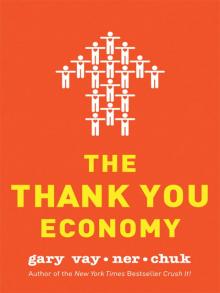 The Thank You Economy
The Thank You Economy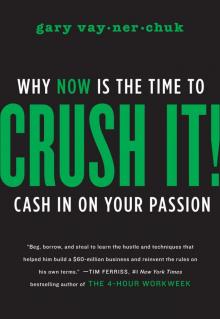 Crush It!
Crush It!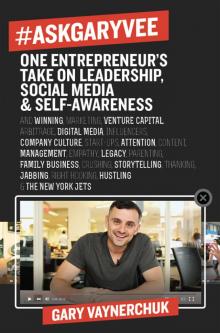 #AskGaryVee
#AskGaryVee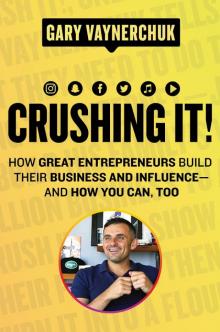 Crushing It! EPB
Crushing It! EPB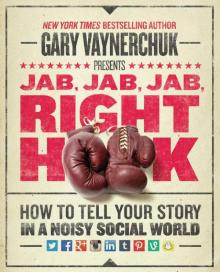 Jab, Jab, Jab, Right Hook
Jab, Jab, Jab, Right Hook